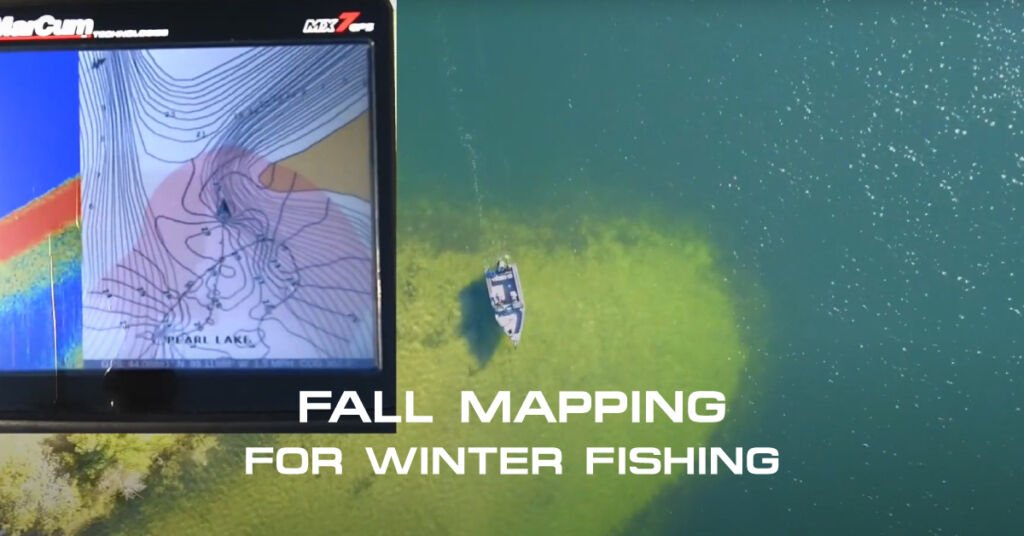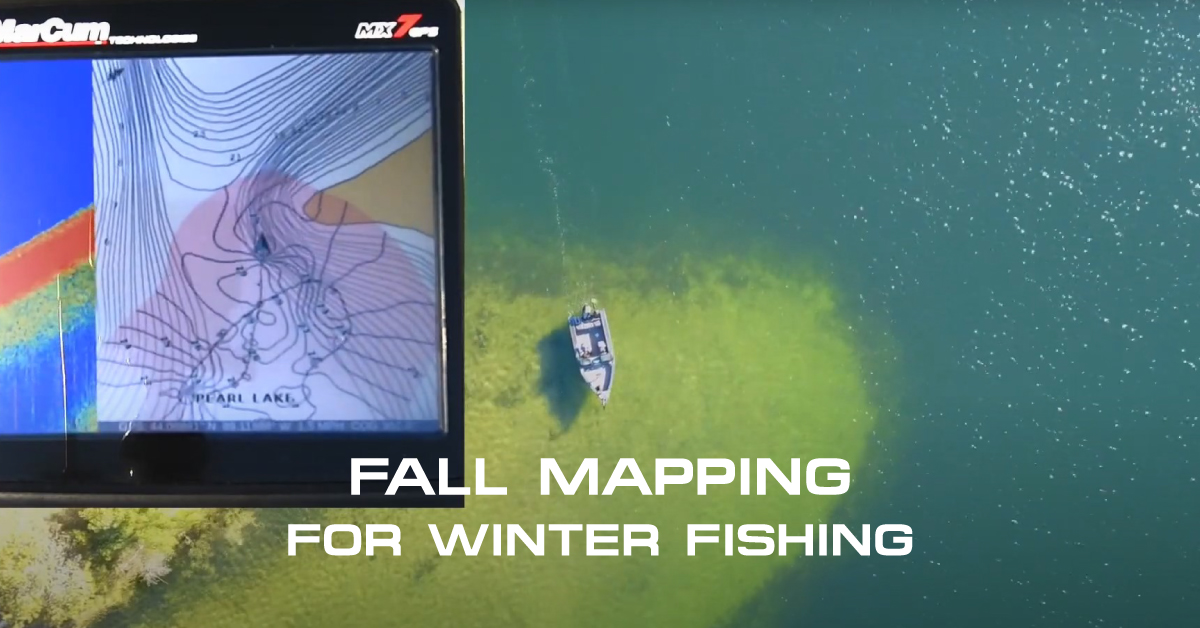
Fall Mapping
for Winter Fishing
While the idea of finding your ice-spots in a boat isn’t a novel one, serious ice anglers should make this a priority this season. No doubt, it’s easier to drive around and scan structure for fish now vs. doing it one ice auger hole at a time come November and December. Advances in electronics make it easier now than ever, such that you can map new water and mark spots with GPS/Sonar combos like the MarCum MX-7GPS.
While it’s likely you already have a sonar system on your boat, just like you don’t use your summer long rods for winter fishing, you won’t be using your boat-mounted graph come ice time. That said, it’s much easier to convert a winter unit for open-water use with the addition of a simple hi-speed skimmer transducer, making your winter MX-7 GPS fish finder unit mapping-capable and more importantly, the same system you’ll use come ice-up. With all these options, it’s more important than ever to be efficient when you’re out there, to have a plan, and use what technology is at your disposal to the best of your ability. Below is a strategy on some home ice scouting that’ll make your winter fishing a whole lot easier.
Electronics Work
Here’s where your Navionics® map capable MarCum MX-7GPS ice fishing sonar comes in. While you’re doing some scanning and electronics work, you might as well be using the same system for open water use that you’ll be using on the hardwater. Not only will your waypoints be better organized, you’ll have everything where you need it in one place, ready to deploy and at your fingertips. Once you’ve installed a hi-speed skimmer transducer to the back of your craft, you’ll be able to directly plug in to the MX-7GPS you’ve come to love as your winter graph. From here, a few simple menu options will allow you to start mapping and saving valuable charts you’ll be able to use on your favorite winter lakes. Especially small panfish holes and out of the way lakes in remote areas have few to no map data, making this feature especially handy for an ice angler. Using your MX7 equipped with Navionics® SonarChart Live™ will allow you to make your own map of your favorite lakes.
Of course, the standard MX-7GPS fish finder is a great tool when it comes to finding fall fish that are often congregated and very visually identifiable. Split your screen into the map-view you marked up in preparation, run your sonar over these locations and spend some time finding fish that will likely move very little in the coming weeks until freeze-up. As a general rule, on sonar, walleyes won’t show up as obviously as panfish, mostly due to their lesser numbers in the food chain, but will be more visible on sonar at depth. Small pods or groups of fish that are primarily within 3 feet of bottom are likely your target here, whereas panfish species will typically be suspended in various parts of the water column. Still, panfish will be schooled up, and the graph should be very full of fish for you to consider it a winter hotspot.
From here, an additional step that’s often overlooked is species ID. Many schools of suckers have been considered as definite walleyes, and I’ve assigned panfish to what actually were white bass, drum, and/or carp many, many times. Fall water is usually a bit clearer, and given the propensity of fish to school up, a simple camera drop done near the sonar ducer usually gives you a glimpse at a few fish. Mobile systems like the Pursuit HD L offer the ultimate in clarity and ease of use, but the larger manta camera head on the VS485c, Mission SD L, and Quest HD L cameras do a better job at tracking under motor power. Whichever camera you’re using, you’ll be pulling down some valuable knowledge to consider, and typically the mental icing on the cake needed to have confidence come first ice.

Map Strategy
Before you ever hit the lake, sit down with your MX-7GPS and Navionics® chip onboard. Separate the lake in question then into basins vs. structure vs. shallows. Get a general feel for what’s predominant by treating each section like its own specific lake. Take stock of each basin and treat it as a whole, eventually dropping a few waypoints of interest that you’d like to check in greater detail. These are almost always irregular edges of the basin, neck-down regions that feed from deep to shallow, or a steep drop off of a great feeding flat with weeds.
Structure is a bit easier to locate, especially main-lake near-shore stuff. This should be a focus for your fall walleye scouting, as good fall winds along big points or pockets make for obvious locations that are in play well into winter. Shallows on the other hand can be expansive, and harder to break down. Use your local knowledge of weeds, structure, and what cover might be shallow to think about panfish and walleye locations you’d like to scan.
Species Breakdown
Once you’ve got your electronics dialed-in, and you’re out on the lake, you need to figure out what you’re going to chase. If the answer is multiple species, you’ve got a bit more work to do, but think in terms of each fish and its typical haunts early ice. Go back in the files to successful ice bites of the past, and try to get a feel for where those fish have been in the fall. The later we get in the soft-water period, odds are good that they’ll be very near winter locations.
For crappies, that’s usually structure or deep weeds as it leads to basin edges. That’s where many of your gills can end up too depending on the lake in question. Bowl-shaped, basin-dominated water bodies will see fish giving more importance to those basin edges, while lakes with predominantly shallow water will see fish scatter to both, often using weeds as the great equalizer in terms of location and quality.
Fall walleyes love the ability to stay on structural breaks and drops by day, and to feed shallow in low-sky or low-light periods. The best structure in the lake, and nearby shallows then make for some great first-ice angling when ice is still forming. Fall baitfish spawns can drive those fish into skinnier water than you’d expect, and more comfortable water temps allow them to use lesser depths than people often look for them. Provided you’re not fishing under high skies and ultra-bright conditions, walleyes from late fall into early ice can be found in less than 10 FOW quite regularly. Pike roam the same waters late fall and into first ice, after both game fish and bait.
Final considerations should take place in the shallows, where the bulk of your camera work could involve looking at changes in substrate, type of structure, and quality or speciation of weed growth. Look too for old docks, brush piles, or hard bottom spots inside of the weedline that may attract first ice gills or crappies. Speaking of weeds, the best panfish anglers I know focus on them nearly exclusively. They look for speciation first, with cabbage being a #1, then coontail a close second. From there, they look at clumps and how they’re spatially arranged, noting that fish will often use big beds of cabbage and coontail as travel routes. That’s especially true when connected by other weeds or another structural element. They find good weeds and fish at specific depths throughout, noting that size classes of crappies and bluegill are often depth dependent among them. Find quality fish, on quality weeds, at a specific depth, and you’ve got a narrow range of area to search in the rest of the lake to find other fish just like them.
Go into first ice this year prepared, and you may never take the fall off to hunt again. While you’re at it, consider dropping a line when you’re done, as the fish can be very eager right now. Just leave a few for the hardwater.
If you want to know more about preparation for the upcoming Ice Season, check out this article.









